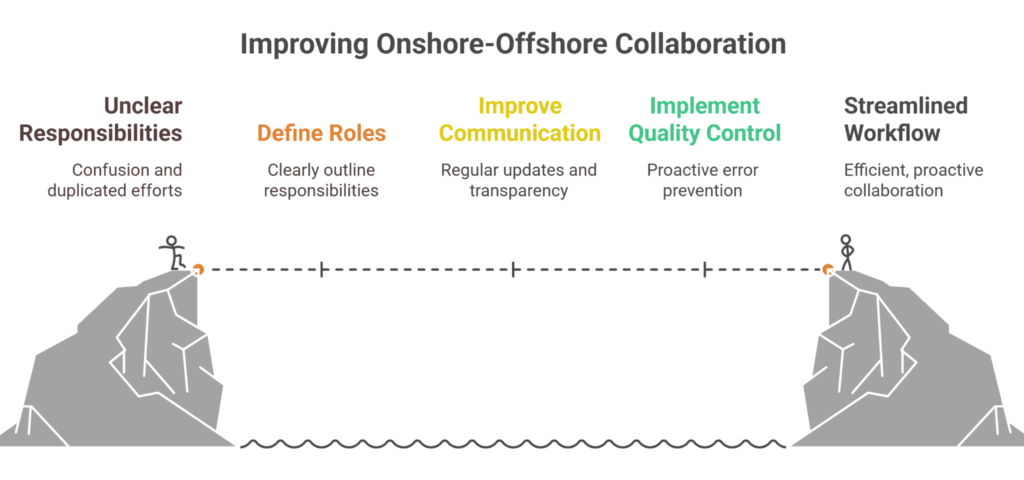Don’t have the time to read?Listen here instead or save to your Spotify playlist. |
You can feel it in every meeting. The eye rolls. The sighs. The passive-aggressive comments about “waiting on someone” or “fixing it ourselves.” This is what the challenges of managing remote employees really look like: tension, misalignment, and growing resentment from your onshore team.
If you’re supervising remote workers and trying to create better cohesion across locations, the friction can feel nonstop. Despite this reality, remote work isn’t going anywhere, as 20% of all jobs in the US are remote.
It’s not that your remote team is underperforming—or that your onshore team is overreacting. The truth is, most of these breakdowns occur in the gray space between the two: unclear expectations, differing communication habits, and a lack of structure.
“Remote work only fails when leadership ignores the structure and systems it demands,” says Ruffy Galang, CEO and Co-Founder, Remote Employee. “If your team’s struggling, it’s likely not the distance that’s the problem, but in the approach to how it’s being managed,” says Ruffy Galang, CEO and Co-Founder, Remote Employee.
In this blog, we’re breaking down six common challenges that get in the way of smooth collaboration between remote and onshore employees—and offering concrete ways to fix them. These aren’t generic tips. They’re proven tactics to help your hybrid team work better, faster, and with less friction.
You’re Likely Facing These Challenges of Managing Remote Employees (and Here’s What You Can Do About Them)
1. Misaligned Communication Styles
Communication breakdowns are serious remote collaboration challenges. They are the fastest way to kill trust between remote and onshore teams. It’s not just what gets said—it’s how, when, and where it gets said that creates friction. When people work in different rhythms, different tools, and different assumptions, even simple tasks can spiral.
What your onshore team says:
“I have no idea what they’re working on.”
“They never respond in time.”
“I’m not even sure if they understood the brief.”
What’s actually happening:
Communication habits vary wildly across time zones, cultures, and personalities.
Some teams default to walls of text. Others keep it cryptic. Some wait for meetings. Others fire off five Slack messages before you’ve had coffee. The result? Misunderstandings, delays, and missed expectations—especially when no one agrees on what “clear communication” actually means.
How to fix it:
- Set communication norms. Define which tools to use and when. Use Slack for quick asks, email for formal updates, video meetings for anything messy or emotional.
- Create a “response time” agreement. For example, 24 hours for email, 2 hours for Slack during working overlap hours. These boundaries can also help prevent digital communication tool burnout, experienced by sixty-nine percent of remote workers.
- Use templates and shared briefs. If your remote team needs to hand something off, use a simple structure: What’s done, what’s next, and where you’re blocked.
- Record, don’t repeat. For complex handoffs, use Loom or video recaps instead of writing novels. This creates more context and reduces the likelihood of confusion.
| Bottom line: Communication isn’t just about talking. It’s about being understood and creating effective remote collaboration processes. |
2. Unclear Roles and Ownership
Even when everyone’s doing their best, onshore teams can feel like they’re left holding the bag.
That frustration usually stems from one thing: no one’s sure who’s actually responsible for what. Without clear ownership roles while managing a team working from home, things fall through the cracks—or worse, pile up on the same few people again and again.
What your onshore team says:
“I thought they were handling that.”
“Why am I finding out about this now?”
“We’re fixing mistakes that shouldn’t have happened.”
What’s actually happening:
When responsibilities aren’t clearly defined, teams default to assumptions.
In a distributed setup, this can mean duplicated work, missed steps, and delayed decisions. It’s not about effort—it’s about structure. When no one is sure who is accountable, the work slows down and trust takes a hit.
How to fix it:
- Assign clear owners—every time. Avoid vague “team” tasks. Every deliverable should have a single point of responsibility.
- Make project tools your source of truth. Whether it’s Asana, ClickUp, or Monday, tasks should live where everyone can see them, not buried in email threads.
- Use RACI for clarity. Define who’s Responsible, Accountable, Consulted, and Informed. It’s simple, but it keeps everyone aligned.
- Be specific and transparent. When a task is assigned, include who’s doing it, when it’s due, and what the next step looks like. No one should have to guess.
| Bottom line: When ownership is clear, collaboration feels smoother, and remote teams challenges decrease—because everyone knows where they stand. |
3. Perceived Imbalance in Workload
When deadlines hit and things get hectic, it’s not unusual for onshore team members to feel like they’re doing the heavy lifting. Whether that’s entirely accurate or not doesn’t always matter—what matters is the perception, and that perception shapes team dynamics fast.
What your onshore team says:
“We’re always the ones staying late to fix things.”
“They log off, and we’re left scrambling.”
“I don’t even know what they do all day.”
What’s actually happening:
In distributed teams, effort isn’t always visible. Remote employees might be working hard, but if their contributions aren’t seen or felt by others, it can create tension. Different time zones, communication delays, and unclear deliverables can all contribute to the sense that someone else is coasting.
How to fix it:
- Make output visible. Track tasks and progress in shared tools. If something’s getting done, let it show.
- Balance deliverables, not just hours. Workload isn’t always about time spent—it’s about contribution. Ensure responsibilities are distributed equitably across teams.
- Create overlap windows. A few shared hours each day can reduce handoff friction and prevent late-night scrambling.
- Acknowledge the work. Recognition matters. A simple shout-out in a shared channel can shift team perception and morale.
| Bottom line: It’s not always about working harder. It’s about making effort visible, valued, and shared. |

4. Inconsistent Quality Standards
Despite the clear advantages of remote work, nothing frustrates an onshore team faster than having to redo work they thought was already done. When the definition of “done” changes depending on who’s doing it—or where they’re doing it—quality starts to slide, and trust goes with it.
What your onshore team says:
“We had to rework the entire thing.”
“This should’ve never gone to the client.”
“It’s easier if we just do it ourselves.”
What’s actually happening:
In remote teams, there’s often no shared playbook for quality. What’s considered acceptable in one region or team may not meet expectations elsewhere. It’s not about lack of talent—it’s about lack of alignment common when managing home workers. Without clear standards and review processes, good work gets lost in translation.
How to fix it:
- Define what “done” actually means. Include quality expectations, formatting, links, documentation—whatever “done” looks like for your team, write it down.
- Build a shared quality playbook. Use real examples. Add screenshots. Show the difference between “good enough” and “great.”
- Use checklists before handoff. Not just for developers. Writers, designers, strategists—everyone benefits from a quick pre-send check.
- Create layered reviews. Have remote team members review each other’s work before it reaches your onshore team. Fewer surprises, less friction.
| Bottom line: Quality doesn’t scale unless it’s defined, documented, and enforced with consistency. |
5. Social Disconnect and Lack of Trust
53% of remote workers don’t feel connected to their coworkers. When your onshore team doesn’t feel connected to your remote team, everything starts to feel transactional. The casual banter, inside jokes, and quick gut checks that build trust in an office? Gone. And what’s left is a team that collaborates… reluctantly.
What your onshore team says:
“I don’t really know them.”
“They’re just names on a screen.”
“I don’t feel like we’re on the same team.”
What’s actually happening:
Remote workers often get stuck in the role of “doers,” while onshore teams handle strategy, client relationships, or higher-touch work. That gap—physical and professional—can easily turn into a wall. Without a personal connection, assumptions take over. Trust erodes. And collaboration turns into silent competition.
How to fix it:
- Create intentional space for connection. Schedule virtual coffees, team games, or even five-minute warmups before meetings. No, it’s not fluff—it’s glue.
- Mix teams deliberately. Don’t isolate remote workers on separate projects. Create cross-location squads with shared goals.
- Celebrate wins publicly. Whether it’s a job well done or a birthday, make it visible. A little recognition goes a long way in making people feel real to each other.
- Use video when it matters. Seeing someone’s face—even occasionally—builds more trust than a dozen perfectly worded emails.
| Bottom line: You can’t build trust without human connection. If your team feels like strangers, collaboration will always feel like a chore. |
| More articles you might like: |
6. Incompatible Tech Stacks
Remote teams can’t deliver their best work if they’re stuck working with the wrong tools—or worse, no tools at all. When systems don’t sync, licenses are missing, or tech access is inconsistent, collaboration becomes more about workarounds than real progress.
What your onshore team says:
“They’re using completely different tools than we are.”
“We’re losing time just getting them access.”
“Their internet connection is too unstable to even stay on the call.”
What’s actually happening:
Tech misalignment is a silent productivity killer. Remote teams might be stuck using VPNs, trial versions, or incompatible platforms. They can’t collaborate in real time. They can’t test properly. They can’t deliver with confidence because they don’t have the same tools as the rest of the team.
How to fix it:
- Standardize your stack. Create a tech checklist for every role and every region. No more patchwork setups.
- Budget for access. Free tools aren’t free if they’re slowing everyone down. Pay for the licenses. It’s cheaper than the rework.
- Centralize tool provisioning. Don’t leave it to individual managers to chase logins and permissions.
- Work with a remote staffing company that equips your remote employees. The right partner doesn’t just deliver talent—they deliver pre-equipped, tech-aligned professionals who are ready to plug into your systems on day one.
| Bottom line: If your tools don’t match, your output won’t either. Equip your remote team like they’re in the same room—because they are on the same team. |
Fix The Challenges Of Managing Remote Employees—For Good
The truth is simple. You can’t manage remote employees the way you manage in-office teams. You’re not in the same room. You can’t see what they’re doing. And no amount of meetings or tracking software fixes that.
That’s why you need Remote Employee®.
Your team reports to a professional office space. You still select your team. You still run your business. We make sure your remote employees show up, stay engaged, and deliver.
Stop trying to manage the unmanageable. Let us make remote work actually work.
Contact us today to get started.










